| Pages:
1
2 |
Pommie
Hazard to Self
 
Posts: 70
Registered: 6-2-2005
Location: Australia
Member Is Offline
Mood: No Mood
|
|
Drying copper nitrate?
A while ago I made some copper nitrate by mixing calcium nitrate and copper sulphate. The ice cream that I ended up with got filtered. I think I now
have some fairly pure copper nitrate. My intention is to (eventually) make some lead dioxide electrodes. Being a bit of a pedant, I'd like to know how
much copper nitrate I have. How on earth do I get this stuff dry? Can I bake it in the oven and then quickly squirrel it into an air tight jar? At
what temp would I have to bake it to get it anhydrous? Is it white when anhydrous? This stuff turns into a liquid so fast. At what temp would I have
to bake it to get the trihydate?
When (if) I get to the point where I have some lead nitrate, can it be used in a similar way to silver nitrate to show presence of chloride?
Mike.
|
|
|
woelen
Super Administrator
        
Posts: 7976
Registered: 20-8-2005
Location: Netherlands
Member Is Offline
Mood: interested
|
|
Making anhydrous Cu(NO3)2 cannot be done from an aqueous solution. The anhydrous compound has eluded chemists for more than a century or so. Only in
the 1960's the anhydrous form was made by reacting copper with liquid NO2 (N2O4), crystallizing the adduct Cu(NO3)2.N2O4 and then carefully heating at
around 85C to drive off the N2O4 solvent.
If you have Cu(NO3)2.xH2O, then heating results in loss of water vapour, oxygen, NO2. What remains behind is plain CuO.
The hydrated solid can be made from the solution with some difficulty. Heat the liquid, until it becomes dark blue and syruppy, then stop heating.
Then let the stuff cool down. It gives a blue crystalline mess, which is fairly pure Cu(NO3)2.xH2O (3 <= x <= 6).
If you heat for too long, then you'll see brown fumes of NO2. If that happens, then you screwed up your stuff and basic copper salts will be formed.
|
|
|
Pommie
Hazard to Self
 
Posts: 70
Registered: 6-2-2005
Location: Australia
Member Is Offline
Mood: No Mood
|
|
I heated it for a couple of days on my lab power supply. I'd guess it was around 40C and got a crystalline mass that looked like long needles. When I
broke it up I had wet crystals. I left it to dry for a few more days and it just didn't get any dryer.
My question really boils down to, how can I use this in any quantative reaction when I can't weigh it.
That just made me think of specific gravity. Is that the only way?
Mike.
P.S There must be a temp where the trihydrate would be produced. Any idea?
|
|
|
12AX7
Post Harlot
    
Posts: 4803
Registered: 8-3-2005
Location: oscillating
Member Is Offline
Mood: informative
|
|
Make a solution and titrate it?
Tim
|
|
|
chromium
Hazard to Others
  
Posts: 284
Registered: 27-6-2005
Member Is Offline
Mood: reactive
|
|
You can make solution of copper nitrate and this can be titrated with Na2CO3 or NaOH to get idea how much copper nitrate known volume of your solution
contains. This solution can be used for reactions or evaporated before use. In any case amount of copper nitrate is not unknown any more.
Another way is to use tables of specific gravity for copper nitrate solutions (if you can find such tables). Boiling point of solution and optical
activity can also be used to determine concentration if you have proper tables.
[Edited on 29-3-2006 by chromium]
|
|
|
chloric1
International Hazard
    
Posts: 1070
Registered: 8-10-2003
Location: GroupVII of the periodic table
Member Is Offline
Mood: Stoichiometrically Balanced
|
|
Iodometry-- What about using standardized potassium iodide solution? The cupric ion oxidizes iodide to elemental iodine which, in turn, can be
titrated with standard thiosulfate. Starch should be mixed so the color transistion is more stark. I have not actually tried this myself but
quantitive testing literature often states this method for estimating copper technique. Be mindfull of any free nitric acid.
Fellow molecular manipulator
|
|
|
MadHatter
International Hazard
    
Posts: 1332
Registered: 9-7-2004
Location: Maine
Member Is Offline
Mood: Enjoying retirement
|
|
Cu(NO3)2
Another way would be to put a known quantity into solution and perform an electrolysis.
The weight of the copper on the cathode will indirectly indicate the amount of copper
nitrate available. You should get 33.88 grams of copper for every 100 grams of nitrate.
From opening of NCIS New Orleans - It goes a BOOM ! BOOM ! BOOM ! MUHAHAHAHAHAHAHA !
|
|
|
12AX7
Post Harlot
    
Posts: 4803
Registered: 8-3-2005
Location: oscillating
Member Is Offline
Mood: informative
|
|
- You could add some ammonia to that solution so you get a better visual indicator of how much copper is left. 
Tim
|
|
|
BromicAcid
International Hazard
    
Posts: 3227
Registered: 13-7-2003
Location: Wisconsin
Member Is Offline
Mood: Rock n' Roll
|
|
All of these methods sound like a pain in the butt. How about assuming your crystals are homogenous and quickly weighing out a known quantity then
heating until they are throughly decomposed to CuO and weighing that product, they have used a similar procedure in industry for many applications
where the pure compound cannot be isolated or is difficult to isolate. Then you'll know the precent copper by weight and you might assume that all of
the copper was present in the form of the nitrate hence you know what weight of each gram of your hydrated salt you weigh is actually the copper
nitrate.
|
|
|
MadHatter
International Hazard
    
Posts: 1332
Registered: 9-7-2004
Location: Maine
Member Is Offline
Mood: Enjoying retirement
|
|
Determination methods
Bromic, that's the simplest method I've seen yet. That would work out to 42.41 grams of CuO
for 100 grams of the nitrate. Every time I made the nitrate I always got the wet crystalline
mass. I used the electrolysis because I already had all the gear on hand. I guess it's really
a matter of preference and whatever you have on hand. Your method requires the most
basic of equipment. One thing I'll try in the future is to remove the excess moisture under
warm conditions and vacuum. I'll be happy if I can at least get it into a dry hydrate.
From opening of NCIS New Orleans - It goes a BOOM ! BOOM ! BOOM ! MUHAHAHAHAHAHAHA !
|
|
|
Steve_hi
Hazard to Others
  
Posts: 196
Registered: 4-12-2010
Member Is Offline
Mood: No Mood
|
|
I Have to renew this thread because now I have an ice cream slurry myself. I reacted about 660 ml of nitric acid with about 200g of copper I removed
the excess copper at what I hope was the end of the reaction. Now i have a small cake pan of copper nitrate but actually don't have any need of it. I
want to just store it for the day I do need it.
Can I just put it in a jar. or will there be some unwanted degradation of the product and if so what might that be?
|
|
|
Hockeydemon
Hazard to Others
  
Posts: 218
Registered: 25-2-2013
Member Is Offline
Mood: No Mood
|
|
As far as I know it will 'degrade' unless you put it in an ampule. Though I'm sure it has some sort of a shelf life in an container. I would think
that it reacts with air exactly the same way as it does in solid copper form.
[Edited on 27-3-2013 by Hockeydemon]
|
|
|
KonkreteRocketry
Hazard to Others
  
Posts: 165
Registered: 12-11-2012
Location: Dubai
Member Is Offline
Mood: No Mood
|
|
I tried this and i think i got a 2.5 hydrate instead of trihydrate, because the mass decreased, without decomposition.
also, i think a vacuum flash might do the work 
|
|
|
Hockeydemon
Hazard to Others
  
Posts: 218
Registered: 25-2-2013
Member Is Offline
Mood: No Mood
|
|
Quote: Originally posted by KonkreteRocketry  | I tried this and i think i got a 2.5 hydrate instead of trihydrate, because the mass decreased, without decomposition.
also, i think a vacuum flash might do the work  |
How hard is it to seal an ampoule under vacuum? Would sealing a glass tube at one end, attaching a vacuum to the other end, and sealing somewhere in
the middle? What kind of torr do I need to be able to achieve?
|
|
|
watson.fawkes
International Hazard
    
Posts: 2793
Registered: 16-8-2008
Member Is Offline
Mood: No Mood
|
|
Quote: Originally posted by Hockeydemon  | | How hard is it to seal an ampoule under vacuum? Would sealing a glass tube at one end, attaching a vacuum to the other end, and sealing somewhere in
the middle? What kind of torr do I need to be able to achieve? |
http://www.ilpi.com/glassblowing/tutorial_ampule.html
|
|
|
jamit
Hazard to Others
  
Posts: 375
Registered: 18-6-2010
Location: Midwest USA
Member Is Offline
Mood: No Mood
|
|
Quote: Originally posted by Pommie  | A while ago I made some copper nitrate by mixing calcium nitrate and copper sulphate. The ice cream that I ended up with got filtered. I think I now
have some fairly pure copper nitrate. My intention is to (eventually) make some lead dioxide electrodes. Being a bit of a pedant, I'd like to know how
much copper nitrate I have. How on earth do I get this stuff dry? Can I bake it in the oven and then quickly squirrel it into an air tight jar? At
what temp would I have to bake it to get it anhydrous? Is it white when anhydrous? This stuff turns into a liquid so fast. At what temp would I have
to bake it to get the trihydate?
When (if) I get to the point where I have some lead nitrate, can it be used in a similar way to silver nitrate to show presence of chloride?
Mike. |
As noted by Woelen, anhydrous copper II nitrate cannot be made using aqueous solution.
Making the hydrated version of copper II nitrate is not easy either. Once you know that you have removed all of calcium sulfate and have a pure
solution of copper nitrate, you need to carefully, at low heat, reduce the solution down to a concentrated solution of copper II nitrate. Then place
the solution in an evaporating dish and put it in a desiccator and put the desiccator into the refrigerator. Allow it to dry for about one or two
weeks.
I've been experimenting with copper II nitrate and its really difficult to crystallize the solid hydrate, especially during summer. In the winter
where the garage is freezing and very dry, its alot easier. Once its dry, I bring the desiccator back into the house from the garage and allow it to
dry further at room temperature until it is completely dry. I then quickly place it into a bottle for storage. In fact, that's what I'm doing right
now. Good luck. Here's some pictures.
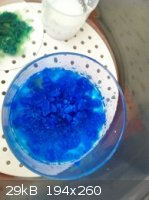 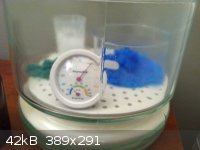
|
|
|
Steve_hi
Hazard to Others
  
Posts: 196
Registered: 4-12-2010
Member Is Offline
Mood: No Mood
|
|
Air dried CuNO3?
From Beginning to end
It seems just being patient and letting it dry thinly spread on a glass pan does the trick
[img]C:\Users\Steve\Pictures\2013-03-31 2013\1up.jpg[/img]
[img]C:\Users\Steve\Pictures\2013-03-31 2013\2up.jpg[/img]
[img]C:\Users\Steve\Pictures\2013-03-31 2013\3up.jpg[/img]
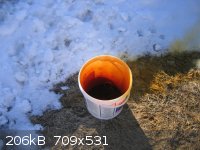 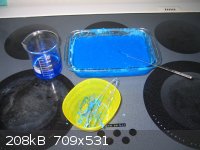 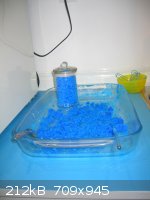
|
|
|
vmelkon
National Hazard
   
Posts: 669
Registered: 25-11-2011
Location: Canada
Member Is Offline
Mood: autoerotic asphyxiation
|
|
You have it in contact with a metal spoon? It will react with it and make copper + FeNO3. I would use glass and plastic only.
|
|
|
Steve_hi
Hazard to Others
  
Posts: 196
Registered: 4-12-2010
Member Is Offline
Mood: No Mood
|
|
You have it in contact with a metal spoon? It will react with it and make copper + FeNO3. I would use glass and
plastic only.
Now I need to make FeNO3 are there other precautions advice or recommendations that differ from Copper nitrate? Instead of Iron Powder as I read in
wicki. Could I use steel wool Or Iron Filings? I only want to make about an ounce Im starting a collection of compounds like Woelen has on his web
site the first are Copper nitrate and copper carbonate I want to have as many colours as possible. Thanks
|
|
|
CHRIS25
National Hazard
   
Posts: 951
Registered: 6-4-2012
Location: Ireland
Member Is Offline
Mood: No Mood
|
|
I have used both steel wool and iron filings for this. Both will give you quite some impurities from carbon but this can be filtered easily after the
reaction has completed. Also a little soak in acetone helps to clean the steel wool, just make sure that after a soak you let it dry thoroughly in a
warm spot, at least an hour. Forgot to add the highly dangerous nitrous oxide gas you will get, so outside is a must, and preferably down wind away
from neighbours if you have any.
[Edited on 8-4-2013 by CHRIS25]
‘Calcination… is such a Separation of Bodies by Fire, as makes ‘em easily reducible into Powder; and for that reason ‘tis call’d by some
Chymical Pulverization.’ (John Friend, Chymical Lectures London, 1712)
Right is right, even if everyone is against it, and wrong is wrong, even if everyone is for it. (William Penn 1644-1718)
The very nature of Random, Chance development precludes the existence of Order - strange that our organic and inorganic world is so well defined by
precision and law. (me)
|
|
|
elementcollector1
International Hazard
    
Posts: 2684
Registered: 28-12-2011
Location: The Known Universe
Member Is Offline
Mood: Molten
|
|
Steel wool can contain a noticeable amount of chromium as well.
Elements Collected:52/87
Latest Acquired: Cl
Next in Line: Nd
|
|
|
Adas
National Hazard
   
Posts: 711
Registered: 21-9-2011
Location: Slovakia
Member Is Offline
Mood: Sensitive to shock and friction
|
|
If there was an anhydrous solvent that could dissolve both KNO3 and CuSO4, it would be easy, but I'm afraid that such a solvent doesn't exist. Yet.

Rest In Pieces!
|
|
|
elementcollector1
International Hazard
    
Posts: 2684
Registered: 28-12-2011
Location: The Known Universe
Member Is Offline
Mood: Molten
|
|
Methanol may be a possibility (pure speculation, no references). Dissolves CuSO4 to some extent (Wiki), no data listed for KNO3.
Elements Collected:52/87
Latest Acquired: Cl
Next in Line: Nd
|
|
|
Steve_hi
Hazard to Others
  
Posts: 196
Registered: 4-12-2010
Member Is Offline
Mood: No Mood
|
|
Possible nitric acid fumes
I was wondering if its possible that after the copper nitrate is put into glass jars if fumes from the nitric acid could still be leaching out into
the air. I notice after being in my lab for a while that my lips and nose become dry hard to describe but I think some chemical or another is giving
off irritating vapours and I'd like to find the offending chemical. Ive bought and stored a number of chemicals in the last month or two, today I
removed the copper nitrate and put them outside to see if it would make a difference. I also noticed that the bottle which I stored the remaining
mother liquer from the copper nitrate was forming crystals along the outside bottom of the bottle. They are amber pet bottles which I bought from the
Pharmacy.
|
|
|
chemcam
Hazard to Others
  
Posts: 423
Registered: 18-2-2013
Location: Atlantis
Member Is Offline
Mood: I will be gone until mid-september, on a work contract.
|
|
Copper Nitrate
The best results I have obtained by trying to make copper nitrate dry is just by letting it sit in dry, open air for a few days. Usually takes about
3-4 days for no more mass to be lost.

|
|
|
| Pages:
1
2 |